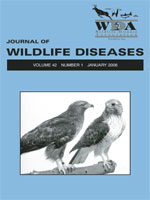Populations of greater sage-grouse (Centrocercus urophasianus) have declined 45– 80% in North America since 1950. Although much of this decline has been attributed to habitat loss, recent field studies have indicated that West Nile virus (WNV) has had a significant negative impact on local populations of grouse. We confirm the susceptibility of greater sage-grouse to WNV infection in laboratory experimental studies. Grouse were challenged by subcutaneous injection of WNV (103.2 plaque-forming units [PFUs]). All grouse died within 6 days of infection. The Kaplan-Meier estimate for 50% survival was 4.5 days. Mean peak viremia for nonvaccinated birds was 106.4 PFUs/ml (±100.2 PFUs/ml, standard error of the mean [SEM]). Virus was shed cloacally and orally. Four of the five vaccinated grouse died, but survival time was increased (50% survival=9.5 days), with 1 grouse surviving to the end-point of the experiment (14 days) with no signs of illness. Mean peak viremia for the vaccinated birds was 102.3 PFUs/ml (±100.6 PFUs/ml, SEM). Two birds cleared the virus from their blood before death or euthanasia. These data emphasize the high susceptibility of greater sage-grouse to infection with WNV.
How to translate text using browser tools
1 January 2006
SUSCEPTIBILITY OF GREATER SAGE-GROUSE TO EXPERIMENTAL INFECTION WITH WEST NILE VIRUS
Larry Clark,
Jeffrey Hall,
Robert McLean,
Michael Dunbar,
Kaci Klenk,
Richard Bowen,
Cynthia A. Smeraski

Journal of Wildlife Diseases
Vol. 42 • No. 1
January 2006
Vol. 42 • No. 1
January 2006
Centrocercus urophasianus
experimental infection
greater sage-grouse
vaccine
West Nile virus




